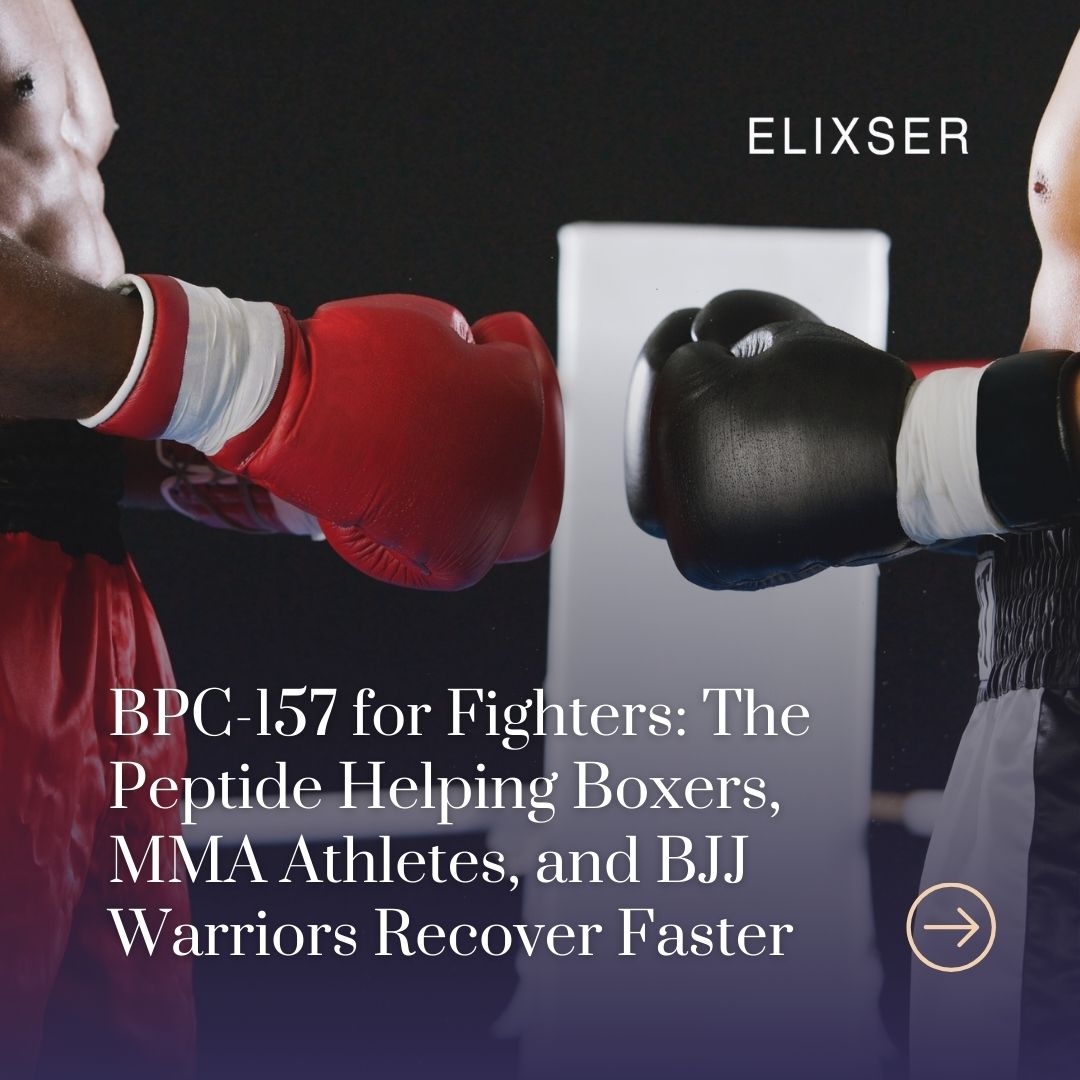Let’s be real—combat sports are a different beast. Whether you’re striking, grappling, or doing a little of both, there’s one thing every fighter knows: pain is part of the game . Sore joints, tweaked shoulders, bruised ribs, torn ligaments—you don’t walk away from sparring or rolling unscathed.
That’s where BPC-157 for fighters comes in—a peptide that’s making waves in the fight community for helping the body heal from the inside out.
Why Recovery Matters Most in Combat Sports Training
Fighters take impact that’s different from your average gym-goer. You’re not just lifting weights—you're:
Absorbing kicks, punches, and elbows
Getting stacked, cranked, or slammed in BJJ
Sparring through tendon strains and tight hips
Taping up nagging shoulder injuries just to make it through training
And because of the intensity, recovery becomes the name of the game . If you can’t heal quickly, you can’t train consistently—and that’s how performance starts to slip.
That’s why injury recovery for fighters has become such a focus—many are turning to peptides for recovery like BPC-157 to stay healthy and perform at their peak.
What Is BPC-157 Peptide? Why Fighters and Athletes Are Using It
BPC-157 stands for “Body Protection Compound 157,” and it’s a synthetic peptide derived from a natural protein in your gut. Sounds random—but it turns out this little 15-amino acid chain has some big-time healing potential.
Originally studied for gut repair, BPC-157 has since shown promise in:
Healing muscle, tendon, ligament, and nerve injuries
Reducing inflammation
Speeding up recovery after trauma
Supporting joint mobility and flexibility
And here’s the kicker: it doesn’t just mask pain—it helps the tissue regenerate.
In simple terms, BPC-157 helps your body repair itself faster—making it one of the most talked-about peptides for athletes in 2025.
How BPC-157 Helps Fighters Heal Faster
1. Tendon and Ligament Recovery
Every fighter has dealt with nagging tendon or ligament injuries. Think:
Elbow pain from overuse in striking or armbars
Knee tweaks from takedowns or leg entanglements
Shoulder strain from guillotines or kimuras
Studies show BPC-157 promotes collagen production and helps regenerate tendon and ligament tissue, even after partial tears [(Pevec et al., 2010)]. This makes it a go-to BPC-157 peptide benefit for fighters dealing with joint strain, sprains, or repetitive stress injuries.
2. Nerve and Brain Protection
Combat sports come with the risk of concussion, nerve compression, and head trauma . In rodent models, BPC-157 has shown neuroprotective effects, helping repair damage to the central nervous system and reducing swelling in the brain after injury [(Sikiric et al., 2018)].
For combat athletes concerned about head trauma recovery, this potential neuroprotective peptide could play a major role in long-term health.
3. Muscle Regeneration and Soreness Relief
After a hard sparring session or a competition, your body feels wrecked. BPC-157 supports angiogenesis (the formation of new blood vessels), meaning more oxygen and nutrients can be delivered to damaged muscle tissue. This helps:
Repair microtears faster
Reduce inflammation
Minimize downtime between training days
Studies also suggest BPC-157 may reduce DOMS (delayed onset muscle soreness) and help restore full mobility after injury. It’s no surprise many pros mention faster muscle recovery with BPC-157 during heavy fight camps or after injury layoffs.
4. Joint Health and Mobility
Between spinning kicks and arm drags, fighters put massive torque on their joints . BPC-157 helps restore joint integrity by:
Supporting cartilage repair
Reducing synovial inflammation
Strengthening connective tissue
This is critical for older fighters or anyone managing chronic joint pain that flares up after training.
How Fighters Use BPC-157: Dosage, Methods, and Protocols
Most fighters using BPC-157 follow short-term cycles—typically 2 to 4 weeks during times of injury or high physical stress.
Delivery methods include:
Oral capsules : easiest and most convenient
Subcutaneous injections : often used near the injury site for localized effect
Some stack it with TB-500 (another healing peptide), but BPC-157 alone has shown powerful effects on its own. Always consult a qualified provider before starting any BPC-157 dosage protocol to ensure proper use and safety.
Is BPC-157 Safe for Fighters? Side Effects and Legality Explained
So far, BPC-157 has shown excellent safety in animal studies , with no reported toxicity—even at high doses [(Sikiric et al., 2018)]. Anecdotal reports in the fight community suggest it’s well tolerated with minimal side effects.
However, it’s still classified as a research compound and isn’t FDA-approved. If you’re considering it, make sure to talk to a provider who understands peptide therapy and combat sports physiology.
It’s also worth noting that BPC-157 legality in sports can vary—while not banned by WADA as of now, athletes should always verify with their specific athletic commission.
Final Thoughts
Fighting is one of the toughest sports on the planet—and the recovery demands are just as brutal. Whether you're dealing with a torn tendon, a stiff neck, a bruised rib, or a sore shoulder, BPC-157 could be the recovery hack your body’s been waiting for .
BPC-157 doesn’t just mask pain—it actively supports tissue repair and recovery, helping fighters get back in the gym, cage, or mats faster, stronger, and more resilient. For anyone serious about recovery in combat sports, this peptide could be a game-changer.
Train hard. Recover smarter.
References
- Pevec, D., et al. (2010). Effects of BPC-157 on Achilles tendon healing in rats. Muscles, Ligaments and Tendons Journal.
- Sikiric, P., et al. (2018). Body Protection Compound BPC 157 and its effects on muscle, tendon, ligament, and brain healing. Journal of Orthopaedic Research.

![GENESIS [Metabolic Support Formula]](http://elixserhealth.com/cdn/shop/files/Product_Photos_for_Genesis_3.png?v=1750197496&width=150)
